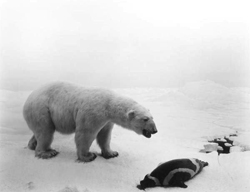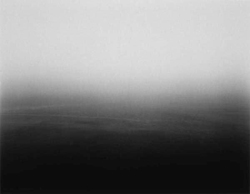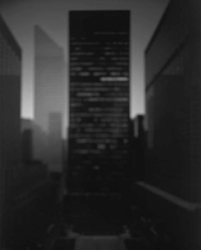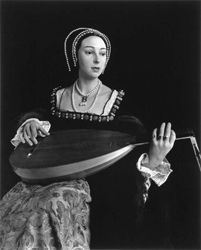Hiroshi Sugimoto (photographer, born in 1948 in Tokyo, living in Tokyo and New York)
Okabe: How long have you been in New York?
in his studio, New York
photo: Aomi Okabe
Sugimoto: I came to New York in 1975, so 32 years. I was in California so I’ve been in the states since ‘70s.
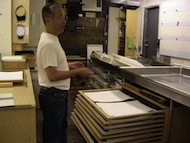
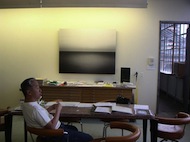
in his studio, New York
photo: Aomi Okabe
Okabe: Why did you go to California?
Sugimoto: I was just travelling around. Then I heard that there’s something interesting going on like drug culture. So I thought that I had to examine what is actually there. I went there and the only place that would accept me was an art school so I entered.
Okabe: When you were studying economics in St Paul’s University, were you related to art culture in any way?
Sugimoto: Not at all. However, I was a member of some dorky advertising group. I was familiar with commercial art and taking photos. At that time, I had an impression that advertising was more advanced than art scene.
Okabe: Were you already taking photos?
Sugimoto: Yes. When I was in high school I was in a photography club. I taught myself how to take photos when I was in junior high school. I got my own darkroom when I was 12 years old.
Okabe: Not so many people have their own darkroom at that young age, are there?
Sugimoto: Maybe. I requested my close carpenter to transform my closet into a darkroom. It is fair to say I came here to study photography, but I already knew everything they taught at the university so I didn’t learn anything new.
Okabe: Was there a change in your attitude towards photos and art scene since you came here compared to what it was in Japan?
Sugimoto: I was interested in culture scene instead of art scene when I was in California. When I was in Japan, it was student revolution era.
Okabe: Were you taking in part of student activism?
Sugimoto: Well, sort of. Though, I majored in economics in St Paul’s University and studied Marxism. I didn’t have enough courage to join the radical.
Okabe: Is it right that you went to California wanting to have a hippy life and see the world?
Sugimoto: I arrived to California when I was travelling around. I was surprised that there was full of oriental mystics influence. I would have never noticed it if I didn’t come here. Everyone asks me, “have you reached enlightenment?” and so on. So I quickly digested what’s inside me and got ready to declare my attitude towards Buddhism philosophy and oriental mystics.
Okabe: A lot of Japanese people who go abroad follow the similar path. You realize that you need to study about Japan and oriental culture when everyone questions you. When you are in Japan, you won’t have much opportunity to be asked that kind of questions. Instead, you desire to know more about foreign culture and share it with your Japanese friends. Being in Japan doesn’t necessarily mean you are an expert of Japan.
Sugimoto: Ordinary people don’t have to know much about. (laugh)
Okabe: Moving on, you came to New York and started working, is that collect.
Sugimoto: Yeah. I started as an assistant of commercial photographers. I always got fired in a couple of days, because I criticize my employer. I knew it wouldn’t do anything good, though. Then I encountered Donald Judd. I was astonished when I first saw his show in New York art scene. I was like, can it be done? I understood that all you need is to come up with some funny idea accompanied with some skills. My belief was, go for all or nothing. So I started visiting the fanciest gallery first and if not succeed, I lowered the aim. Usually people start from the bottom, but I was too sassy for it, I guess. My closest friend among New York artists was Tomio Miki. It was very short time, less than a year, but we were so close, tripping together. (laugh) We were always at Ushio Shinohara’s flat and partied every day. I only could speak Japanese though, they were discussing on so-called artistic theory, being stoned at the same time. Most of the people there were graduates of Tokyo University of the Arts. I first thought it was interesting, but in about half a year I came to realize that this is how boring these graduates are. Miki was the most interesting one among the group, so much better than Shusaku Arakawa.
|
|
|
Okabe: You have been working in New York since then. How do you think the city changed?
Sugimoto: New York changes in every 10 years. There’s a cycle that is similar to economic depression that comes around once in every 10 years.
Okabe: The painting movements came back to New York since 4 or 5 years ago, right?
Sugimoto: Yes. It means that we come back always to physical matters. It’s only a basic form whether you go conceptual or visualize it. Right now, I feel that the conceptual directions stuck somehow.

Sea of Buddha�@1995 ©Hiroshi Sugimoto Courtesy Gallery Koyanagi
Okabe: Is there a museum or a collector in Japan that has a collection of your artworks?
Sugimoto: Some Japanese public museums have a few but not a whole collection. So The National Museum of Art, Osaka recently purchased sufficiently. But, in 1978, when I had a show at That Museum, they didn’t purchase any of the artwork.
Okabe: Is there any collectors in Japan?
Sugimoto: Well, Mr. Mori, who founded Mori Art Museum loves Architecture, so he bought some of the photos of “Architecture” series, but that’s it.
|
|
|
Okabe: About photography, when you decide the number of editions, do you consider the need in the market?
Sugimoto: Basically, the large sized photos have 5 editions and small ones are 25. I am actually decreasing the number of editions. I’m about to reach my sixties so I have to balance it with the time I have left. It is no good to waste my time supplying old editions. I’d like to do something new all the time. I’ll calculate how much I need to sell the work to get the money and to pay the tax so on, in order to do what I want to do for next 5 or 10 years. It would be perfect if I could run out all my money when I go.
Okabe: You say you want to use your money for what you want to do. You have been collecting oriental artifacts. Recently you have purchased some Japanese painting from Taisho era and an ancient fossil. Do you have any plans for having those collections on display?
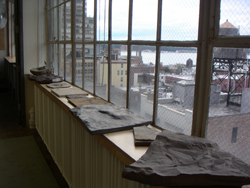 |
fossils acquired by Hiroshi Sugimoto |
Sugimoto: I will always create my pieces being inspired by those collections and also have the ideas of exhibition from these collentions.
|
|
(At Chelsea studio, New York, June 4th, 2006, Translated by Mei Matsubara)
���{���i�i�ʐ^�Ɓ@�P�X�S�W�N�������܂�A�����ƃj���[���[�N�ݏZ�j
���������݁F���{����̓j���[���[�N�ɗ��Ă��łɉ��N���炢�ɂȂ�܂����B
���{���i�FN.Y��1975�N�ɗ�������A32�N�B���̑O��3�A4�N�J���t�H���j�A�ɂ����̂ŁA70�N����A�����J�ɂ����ł���B
�����F�ŏ��͂Ȃ��J���t�H���j�A�ɁH
���{�F�t���t�����ꒅ������ł���B����łȂm��Ȃ����ǁA�h���b�O�J���`���[�Ƃ��������������낢���Ƃ��N�����Ă��������Ă�����ŁA���ꌟ�����邽�߂ɂ��炭���Ȃ��Ƃ킩��Ȃ��Ǝv���Ă����̂��^�̂��B����łƂ肠�����w�Z�ɓ���̂ɃA�[�g�X�N�[���Ȃ�������Ă�����ŁA�������������ˁB
�����F�����̗�����w�Ōo�ς���Ȃ����Ă����Ƃ��́A�ʂɃA�[�g�ƊW�Ȃ�������ł����B
���{�F�S�R�W�Ȃ������ł���B�ł��L��������Ƃ����ςȃ����C��ɓ����ĂāA������R�}�[�V�����A�[�g�Ƃ����������ʐ^�݂����̂͂���Ă������ǂ��B�����͍L���̂ق����A�[�g�̐���s���Ă�������������܂��B
�����F���łɓ�������ʐ^���B����������Ă����̂ł��ˁB
���{�F�ʐ^�͍��Z�̎��ʐ^���ɓ����Ă�������A�܂����w�̎����玩���łقƂ�ǃ}�X�^�[���Ă����A�Î������w�����Ă���12�̂Ƃ����玝�����B
�����F�������ł��ˁA���̍����玩���ňÎ��������Ă����l�͏��Ȃ��ł��傤�B
���{�F�o����̑�H����ɖ��������������������č���Ă���������ǁA�������ɂ��Ďʐ^������܂����Ƃ����Ă��ʂɑS���m���Ă邱�Ƃ�����Ă邾���ŁA�Z�p�I�ɂ͉����������Ă�������Ƃ��͂Ȃ������ł��ˁB
�����F�����ʐ^�ƃA�[�g�V�[���Ƃ̂������Ȃǂ́A���{�ɂ����Ƃ��ɂ͂��܂蕪����Ȃ������ł��傤�ˁB
���{�F�J���t�H���j�A�ɂ����Ƃ��̓A�[�g�V�[������Ȃ��ăJ���`���[�V�[���ɋ����������ē��{�ɂ����Ƃ����w���^���̎��ゾ��������B
�����F�w���^�����Ȃ��������������̂ł����B
���{�F�ǂ��������Ă����Ƃ��������ǁA�����̌o�ϊw���̓}���N�X�o�ϊw����������ˁB����܂��ł��ߌ��h�ɓ��邾���̓x���Ƃ������x�ʂ͂Ȃ���������Ȃ��i�j�B
�����F�J���t�H���j�A�ł̓q�b�s�[�݂����Ȋ����ŁA�����������E�����Ă݂����Ƃ����v���ő؍݂��Ă����킯�ł��ˁB
���{�F�t���t�����E�𗷂����҂��Ċ����ŗ��ꒅ�����̂��J���t�H���j�A�B���x�͓��m�_���`����ŋ��������ǁA���{�ɂ���Ƃ���͑S�R�����o���Ȃ��B�݂�Ȃ��炢�낢�땷�����킯�ˁB���܂��͌���Ă��邩�Ƃ��A����œ��m�_���`�̊�{�A�����I�ȓN�w�Ȃǂ��U�U�U�b�Ƒ�}���Ŏ��ȗ��ŏ��������̂ˁB
�����F�C�O�ɍs�������{�l�̑������A���Ɠ����悤�Ȍo�܂�H��܂��ˁB���{�Ⓦ�m�̂��Ƃ���邩��A�����Ƃ��Ȃ��Ă͂ƂȂ�B���{���ƕ�����邱�Ƃ��Ȃ����A�ނ���ٕ����ɂ��ē��{�̗F�B�ɋ��������A�V�����v�z��m�肽���ƂȂ�̂ŁA�t�ɐ��m�̕����肷�邱�ƂɂȂ邯��ǁB��������{�ɂ��邩��Ƃ����ē��{�̂��Ƃ�m���Ă���Ƃ͌���܂���B
���{�F���ʂ̐l�͑S�R�m��Ȃ��ł���i�j�B
�����F�j���[���[�N�ɏo�Ă��āA�d�������낢��n�߂�ꂽ�킯�ł���ˁB
���{�F�܂��R�}�[�V�����̎ʐ^�Ƃ��Ȃ̃A�V�X�^���g��T���Ă��������ǂ��A2�A3�����������Ȃ��ŃN�r�ɂȂ����Ⴄ�킯�B�ق����ᔻ���邩�炢���Ȃ���ˁB �������̎ʐ^�Ƃ�ᔻ���Ă��d���Ȃ����ǁB�����������Ă��邤���Ƀj���[���[�N�̃A�[�g�V�[���ŁA�h�i���h�E�W���b�h�̓W����������肵�āA�V���b�N�������ˁB����Ȃ̂ł����́H�ʔ������Ƃ��l���Ď�悪��肯��Ⴂ�����Ă��������i�j�B���̂Ƃ��l���Ă����������Ƃ��ẮA�Ƃɂ�����ԏォ�炠�����čӂ���B��L�܂��������Ԃ�����L�Ɏ����čs���āA���߂�������ǂ�ǂ�ǂ�ǂ�~��Ă��������B���ʂ͋C��ꂵ�āA���������Ă�������ǁA�������ӋC�������낤�ˁB �j���[���[�N�̃A�[�e�B�X�g�̒��ł͎O�ؕx�Y�ƈ�Ԓ��ǂ��āA�ق��1�N�ɂ������Ȃ������炢���������ǁA���Ȃ�x�b�^���ꏏ�ɂ����ˁB���̓h���b�O���Ԃ�(��) ��������L�i�j�̃��t�g�ɏo���肷��悤�ɂȂ��āA�����肵�Ă�킯�B���{�ꂵ���b���Ȃ��̂�����nj|�p�_�Ƃ��B�قƂ�nj|��o�ĂāA���{�̌|��̑����ŁA�����x���x���ɂȂ�܂ň���Ō|�p�_�Ə̂�����̂�����Ă�킯�B�ŏ��͖ʔ������ȂƎv���čs���Ă��̂ˁB�ł����N���t�������Ă邤���Ɂu���A���{�̌|�呲�ƃ��x�����Ă���Ȃ��v���Ďv�����i�j�B���̃O���[�v�̒��ŁA�O�͈�Ԃ܂Ƃ����Ă������ʔ����āA�r��C��Ȃ�����ۂǂ����Ǝv����B
�����F���{����͂��ꂩ�炸���ƃj���[���[�N�Ŋ���Ȃ����Ă�킯�ł����A�j���|���[�N�̕ω��ɂ��Ă͂������ł��傤�B
���{�F�j���[���[�N��10�N���炢�łǂ�ǂ�ω�����B��������10�N�T�C�N���ł܂���Ă��āA�s���̃T�C�N����10�N�P�ʂ��Ă����̂Ɠ����悤�Ȋ����B
�����F4�A5�N�O����A�܂��y�C���^���[�ɖ߂��Ă܂��ˁB
���{�F�������ˁB�����畨���I�ȃ��m�ɏ�ɐU��߂���Ă�킯�B�ϔO�I�ɂȂ邩�r�W���A���C�Y����邩�Ƃ����̂͑�g�̔g�ŁA����ȏ�͂ǂ����s���l�܂�݂����Ȋ����͂��邯�ǁB
�����F���{����̍�i���R�����Ă���R���N�^�[����p�ق́A���{���Ƃǂ��ł��傤�B�܂Ƃ܂��ē����Ă���Ƃ���A����̂�����B
���{�F���{�̍��������p�ق͂��ꂼ��A���傱���傱���Ɣ����Ă���Ă܂����A�܂Ƃ܂��ē����Ă͑S�R�Ȃ������̂ŁA�ŋ߂͍������۔��p�ق��܂Ƃ߂Ēu���Ă��ꂽ���ǁA1978�N�ɍ������۔��p�ق̖����Ւn�̋��قœW���������Ă����̂ɁA���̎��ɂ͉�������Ȃ�������ł���B
�����F���{�ł́A����Ƃ������R���N�^�[�����Ȃ��̂ł����H
���{�F�ŋ߁A�X���p�ق̐X����l�����z�D��������A������x�A���̓W����́u���z�v�̕������������Ă��ꂽ���ǁB
�����F �ʐ^�ł�����A�V��Ȃǂ̃G�f�B�V�����̐������肷��Ƃ��ɂ́A�����������v�̍��܂�Ȃǂ�������x�A�l�����Č��߂邱�Ƃ�����܂����B
���{�F�G�f�B�V�������͂��������̂���傫���̂�5�ŏ������̂�25�ƌ��܂��Ă��܂��B�ŋ߂ł͂ނ���ǂ�ǂȂ����Ă����āA����50���㔼�ł�������60�Ƃ����N��ɂȂ�ƁA�����̗]���Ƃ̃o�����X���l���Ȃ������Ă����Ȃ�����Ȃ�Ȃ��B����ɃG�f�B�V�����Ő̂̎ʐ^����Ă��Ă����Ă��傤���Ȃ����B��ƂƂ��ĐV�������Ƃ���肽������B��������������5�N����10�N��ɂ�肽�����Ƃɑ��Ăǂꂭ�炢�̗\�Z���K�v���Ƃ����Ƃ��납��t�Z���Ăǂꂭ�炢����グ�Ȃ����Ⴂ���Ȃ��Ƃ��A�ŋ��͂ǂꂭ�炢�����Ƃ��l���āA�������c���Ă����傤���Ȃ��킯�����A�g�����肽���킯�ˁB
�����F��肽�����Ɏg�������Ƃ������ƂŁA�̂��炨�����̓��m�̌Ô��p�R���N�V���������ł͂Ȃ��A�ŋ߂͑吳����̓��{���ꂽ��A�Ƃ��ɐ�j����̉����I�[�N�V�����ŗ��Ƃ��ꂽ�肵�Ă��āA���������R���N�V�������̂���i��W����̃f�B�X�v���C�ȂǂɎg�����Ƃ��l���Ă���������̂ł��ˁB
���{�F�R���N�V���������Ȃ���A���������̂���G������Ȃ���A�����̍�i�\���Ă����B
�i�j���[���[�N�A�`�F���V�[�̃X�^�W�I�A2006�N6��4���j

